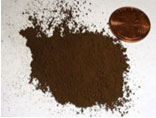Một dải rộng các sản phẩm bột màu, sơn bột, mực in tồn tại dưới nhiều dạng như nguyên liệu thô và thành phẩm. Phân bố kích thước hạt của những vật liệu này quyết định bề ngoài, chất lượng, chức năng và quá trình sản xuất ra chúng. Những mẫu này bao gồm một dải rộng về phân bố hạt. Đó là lý do tại sao phân bố kích thước hạt Horiba là hệ thống được ưu tiên trong những ngành công nghiệp này. Máy đo LA-950 có dải động học 10 nm – 3000 µm mà giúp cho nó có thể đo mọi sản phẩm từ những bột màu kích thước sub-micron như là bột carbon, TiO2 tới bột màu hữu cơ.
Titanium Dioxide (TiO2) là loại bột màu sử dụng trong ngành sơn và nhiều ứng dụng khác. Phân bố kích thước hạt của titan dioxit rất quan trọng vì nó ảnh hưởng tới nhiều đặc tính vật lý mà quyết định chất lượng của thành phẩm. Phân tích kích thước hạt được tiến hành tiêu biểu bởi công nghệ tán xạ ánh áng, đặc biệt là LA-950 với nhiều nhà sản xuất TiO2 trên thế giới.

- Overlay of wet slurry and dry powder titanium dioxide measurements with the LA-950.
Particle size is a critical physical characteristic of pigments, affecting many performance factors including gloss and tinctorial strength. Laser diffraction is the most popular method of particle size analysis for the milling process, allowing close control and optimization of a number of final product performance criteria. A study was performed on four organic pigments (2583 Diarylide Yellow 83, 1274 Hansa Yellow 74, 2574 Hansa Yellow 74, and 5576 Phthalo Blue 15:3) using the LA-950 PowderJet dry measurement accessory to optimize a method and test reproducibility.
Particle size is directly related to hiding power in pigments. Due to its speed and wide size measurement range, laser diffraction is an ideal tool for tracking the grinding process and therefore controlling the resulting pigment performance. Laser diffraction results rapidly tell the manufacturer when a product is sufficiently small and therefore allows optimum use of manufacturing equipment.

- Click to enlarge: Plot of hiding strength and geometric mean particle size as a function of grinding time.
Powder coatings are alternatives to paints that are comprised of a resin and a pigment. The powder is sprayed on the part and attracted by the electrostatic charge applied to the part. The item is then heated in an oven to cure the resin and form a solid layer. Particle size is important to provide the optimum surface finish and minimize process waste. As with other pigments, the size of the largest pigment particles affects the surface finish. Larger particles will protrude above the surface, leaving a rough texture. Because powder coatings are applied with spray guns, similar to paint, large particles can clog the spray nozzle orifice.
Synthetic iron oxide powders are used primarily for their pigmentary and magnetic properties (although not all types of iron oxide are magnetic). Iron oxide powders are the most widely used of all colored inorganic pigments, used in concrete products, paints, plastics, and other media. Due to their chemical and magnetic properties, iron oxide powders also find significant commercial usage in electromagnetic components, catalysts, toners, magnetic recording media, and other applications.
Download the application note on particle size measurement of iron oxides (You need to be logged in).
Inks are a liquid dispersion of pigments for writing or printing. The product is a mixture of a number of components, the majority being the pigment particles in some liquid carrier. A number of additives are usually included to modify viscosity, drying, stability, or color characteristics. Particle size of the pigment particles can significantly affect the color strength, surface finish, and durability of the final product. In addition, the particle size of the pigments must be small enough that they do not block the nozzles of the printing mechanism.
Inks may require either water or an organic solvent dispersant, and sometimes a surfactant .The refractive index depends on the pigment used. Ultrasound is typically not required for a well formulated, stable ink. These submicron dispersions are ideal samples for the LA-950 Particle Size Analyzer since it possesses the best nanoparticle performance on the market. The result shown below with a Dv50 of 106 nm doesn’t even come close to the low end size limit of the LA-950. See the test method on measuring 30 nanometer LUDOX TM.
Chromium oxide is a green material. The dimethicone treatment adds a degree of “slip” to the particles allowing for better color saturation. The resulting green pigment is predominantly used in cosmetics manufacturing.
This sample was slightly hydrophobic, so Micro-90 surfactant was used to wet a small amount of sample in a beaker. The dispersant used was water with 0.1% sodium pyrophosphate. The result from this analysis is shown below.



